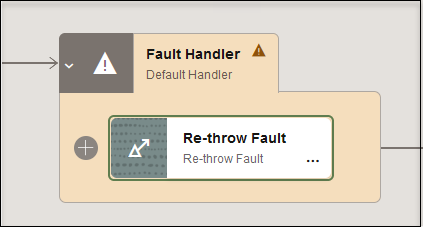Catch Faults with a Re-throw Fault Action
You can send failed messages to the error hospital for further analysis with a re-throw fault action. If the integration contains a defined global fault, the error captured by the re-throw fault action is sent through the global fault and onto the error hospital for analysis. If no global fault is defined, the fault is sent directly to the error hospital for analysis. The re-throw fault action can only be placed inside the fault handler section of a scope action. The re-throw fault action operates as a catch all block and is processed if a fault is thrown by an invoke action in the scope. However, the re-throw fault action does not have a specific catch named for it. The following example describes how to define a re-throw fault action in a scope action.
-
Create an integration that includes a scope action. See Manage a Group of Actions and Fault Handlers with a Scope Action.
- Double-click the scope.
- Select Actions
 , then Fault Handlers, and then
Default Handler.
, then Fault Handlers, and then
Default Handler.
The scope action is now in fault design mode.
-
Add a re-throw fault action to an integration in either of the following ways:
- On the right side of the canvas, click
Actions
 and drag the Re-throw Fault action
to the + sign.
and drag the Re-throw Fault action
to the + sign.
- Click
 at the location where you want to add the re-throw fault
action, then select Re-throw Fault.
at the location where you want to add the re-throw fault
action, then select Re-throw Fault.
This creates a re-throw fault action in the fault handling section of the scope action.

Any faults captured by this action are passed to the error hospital for analysis. Because of this fault, the integration flow is terminated.
- On the right side of the canvas, click
Actions
-
Double-click the scope action to return to design mode.
The Re-throw Fault action is hidden.
-
Design your scope action.
- To return to fault mode, double-click the scope.
- Select Actions
 , then Fault Handlers, and then
Default Handler.
, then Fault Handlers, and then
Default Handler.